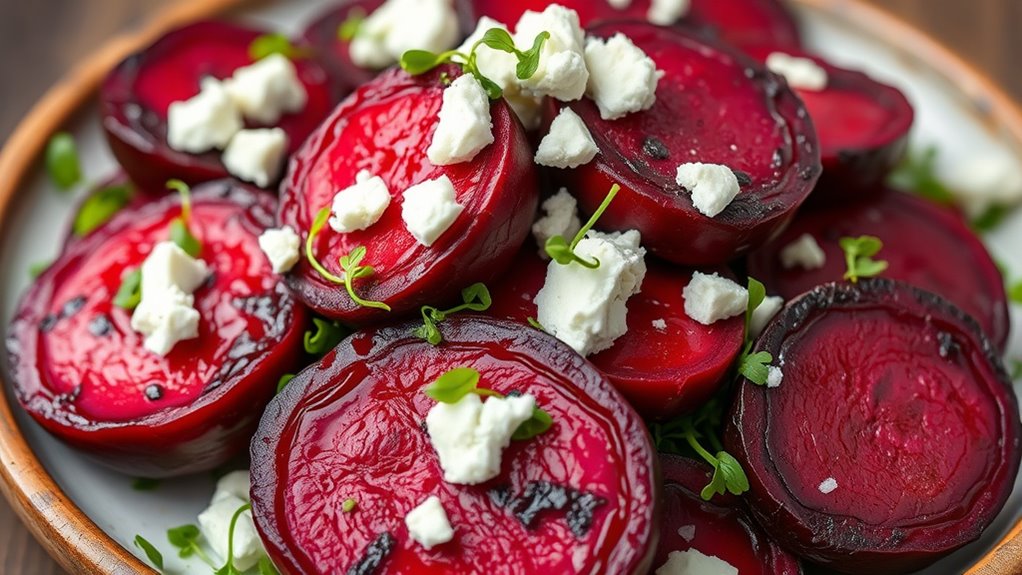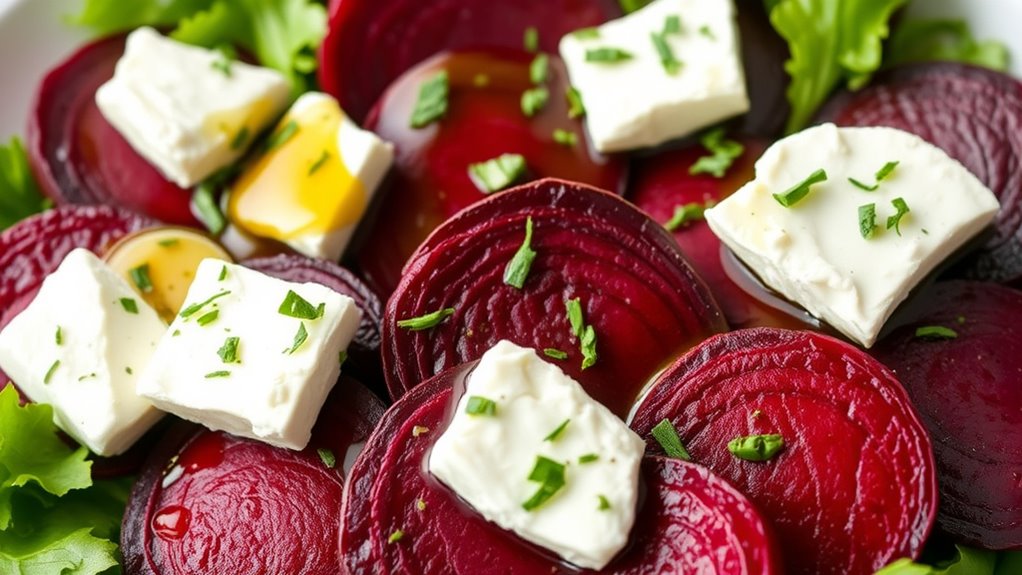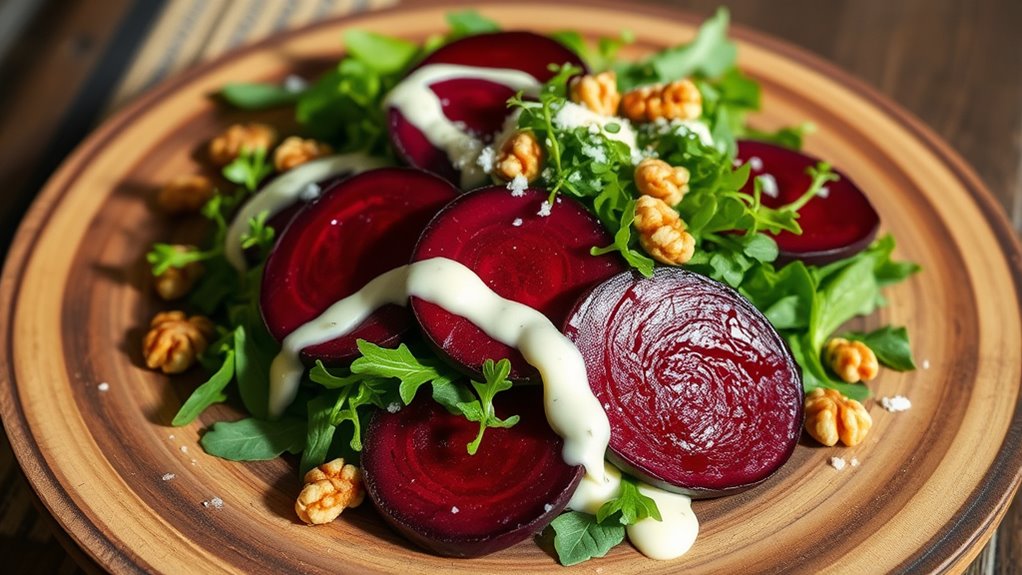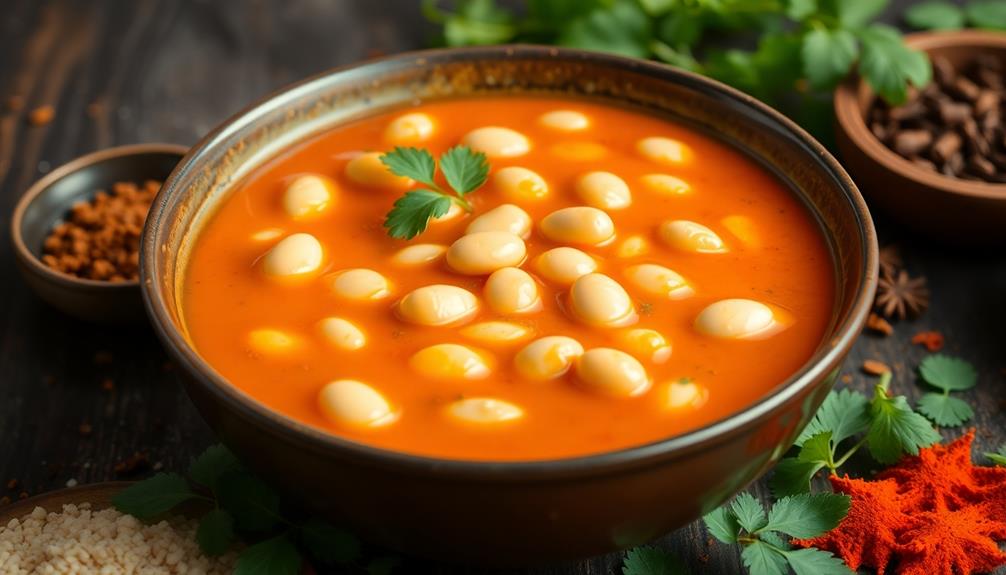To make a butter-roasted beet salad with goat cheese, start by selecting fresh, firm beets and roasting them at 375-400°F until tender, wrapped in foil for extra moisture and color. Prepare a butter glaze with honey, lemon, and melted butter, then coat the roasted beets before peeling and slicing. Assemble the salad with goat cheese, herbs, and a tangy vinaigrette, and enhance presentation with garnishes. For tips on perfecting each step, keep exploring this flavorful, colorful dish.
Key Takeaways
- Select fresh, firm beets and roast them at 375°F–400°F until tender for optimal flavor and color.
- Prepare a smooth butter glaze with honey or maple syrup and lemon juice to enhance caramelization.
- Roast beets wrapped in foil, then peel and cool slightly before assembling the salad.
- Arrange roasted beets on plates with goat cheese crumbles, drizzled with butter glaze or vinaigrette, for visual appeal.
- Garnish with herbs or edible flowers, and serve with complementary wines like Sauvignon Blanc or Chardonnay.
Selecting and Preparing Fresh Beets

When selecting fresh beets, look for firm, smooth roots with vibrant color and intact greens if attached. Different beet varieties, like Chioggia, golden, or Detroit Dark Red, offer unique flavors and appearances, so choose based on your preference. Opt for beets that feel heavy for their size, indicating juiciness and freshness. Proper beet storage is key to keeping them fresh longer—store unwashed beets in a cool, dark place or in the refrigerator’s crisper drawer, preferably in a perforated bag. Avoid beets with cracks, soft spots, or blemishes, as these indicate age or damage. Preparing beets involves trimming the greens and roots, but it’s best to leave the skin on until cooking to preserve flavor and nutrients.
Roasting the Beets to Perfection

To get the best flavor, you need to roast your beets just right. Focus on choosing fresh, firm beets and using the right techniques to guarantee even cooking. When done properly, your beets will be tender inside with a rich, caramelized exterior. For optimal results, consider proper roasting techniques to ensure even heat distribution and consistent doneness.
Selecting Fresh Beets
Ever wondered how to choose the best beets for roasting? Start by exploring different beet varieties, such as red, golden, or chioggia, to find the flavor and color you prefer. Freshness is key, so look for firm, smooth beets without wrinkles, soft spots, or blemishes. When beet farm sourcing, ask if the beets are freshly harvested; locally sourced beets tend to be fresher and more flavorful. Avoid beets with green tops, as that can indicate age. Choose smaller to medium-sized beets, which tend to be tender and cook evenly. Check the stems; they should be vibrant and firm. Selecting high-quality, fresh beets ensures your roasted salad will have the best flavor and texture.
Optimal Roasting Techniques
Roasting beets to perfection requires careful temperature control and timing to bring out their natural sweetness and vibrant color. To preserve their striking beet color, set your oven between 375°F and 400°F, and roast until they are tender when pierced with a fork. Wrapping beets in foil helps retain moisture and ensures even cooking, which enhances beet color preservation. Keep an eye on the clock; depending on size, roasting can take 45 to 60 minutes. Once done, let them cool slightly before peeling, which prevents color loss. Properly roasted beets develop a sweeter flavor, creating a perfect base for cheese flavor enhancement. This technique guarantees your beets are both visually stunning and rich in flavor, elevating your salad to a new level. Additionally, understanding retirement savings plans and their management can help you plan for future financial security beyond your culinary pursuits.
Making the Butter Glaze for Roasting

Creating the butter glaze is a crucial step that guarantees your beets develop a rich, flavorful coating during roasting. Start by choosing high-quality butter—unsalted is best for control over salt levels and flavor. Melt the butter gently over low heat to preserve its richness and prevent burning. To achieve the perfect glaze consistency, whisk in a touch of honey or maple syrup for sweetness, and add a splash of lemon juice for brightness. This creates a smooth, slightly viscous mixture that will evenly coat the beets. Make sure to stir continuously, ensuring the ingredients blend well. The right butter quality and a balanced glaze consistency are essential for delivering the depth of flavor and beautiful caramelization that make this dish exceptional. Additionally, using automated cleaning features can help maintain hygiene in your kitchen tools used during preparation.
Cooling and Peeling the Beets

Once the beets have finished roasting, it’s important to let them cool slightly before handling. Cooling makes peeling easier and safer, preventing burns. To peel, hold each beet with a paper towel and gently rub off the skin with your hands or a vegetable peeler. Removing the skin reveals vibrant, tender flesh perfect for your salad. Proper cooling also helps preserve beet nutrition, as overheating can cause nutrient loss. Once peeled, store the beets in an airtight container in the fridge if not used immediately; they’ll keep for several days. Proper beet storage maintains freshness and flavor. Peeling and cooling your beets properly ensures you get the most health benefits from their high fiber, antioxidants, and essential nutrients, making your salad both delicious and nutritious. For a refined touch, consider using a preppy dog name inspiration to name your vegetables for fun or themed meals.
Assembling the Salad With Beets and Goat Cheese

Start by arranging the warm beets on your plate, then gently place crumbles of goat cheese on top. Think about how you want to layer the colors and textures for visual appeal. Finish by garnishing with fresh herbs or a drizzle of dressing to make the salad inviting. For an extra touch, consider adding a light vinaigrette that complements the flavors and enhances the presentation.
Arranging Beets and Cheese
To assemble the salad, carefully layer the roasted beets on a serving platter or individual plates, spacing them evenly. This allows their vibrant beet color to stand out and creates a beautiful base. Next, gently add slices of goat cheese, considering the cheese texture—creamy yet crumbly—that complements the beets. To enhance visual appeal and flavor, consider these steps:
- Arrange the beets in a circular or linear pattern for symmetry.
- Place cheese slices or crumbles on top, ensuring even coverage.
- Drizzle with any remaining butter from roasting for added shine and flavor.
- Finish by lightly seasoning with salt, pepper, or herbs for contrast.
Incorporate natural materials to create a warm and authentic presentation that echoes farmhouse design elements.
This arrangement highlights the contrast between the beet color and cheese texture, making the salad both stunning and appetizing.
Garnishing for Visual Appeal
After arranging the beets and goat cheese, adding garnishes transforms the salad into a visually striking dish. Use edible flower accents to introduce vibrant pops of color that catch the eye. Place a few carefully selected flowers on top or around the salad for an elegant touch. Complement this with colorful microgreens, which add freshness and texture while enhancing visual appeal. Scatter microgreens loosely over the beets and cheese, creating a layered, dynamic look. These garnishes don’t just beautify the dish—they also add subtle flavor contrasts and freshness. Keep the placement intentional, balancing colors and shapes for a cohesive presentation. With thoughtful garnishing, your salad becomes not only delicious but also a feast for the eyes. Additionally, incorporating handcrafted wooden utensils can elevate the serving experience, emphasizing quality and attention to detail.
Choosing the Right Herbs and Seasonings

Choosing the right herbs and seasonings can elevate your butter-roasted beet salad by adding depth and balance to its natural sweetness. The key is to focus on herb pairing and seasoning balance, ensuring each flavor complements the beets and goat cheese. Consider these options:
- Fresh thyme – Offers earthy notes that enhance the beet’s natural flavor.
- Dill – Provides a bright, slightly tangy herb that pairs well with the sweetness.
- Basil – Adds a sweet, aromatic touch that complements the richness of butter.
- Black pepper – Brings a subtle heat, balancing the sweetness and creaminess.
Use herbs sparingly to avoid overpowering the delicate flavors. Adjust seasonings based on your taste to create a harmonious, flavorful salad. Incorporating flavor balancing techniques can help ensure each element is in harmony, enhancing the overall dish.
Drizzling With a Complementary Vinaigrette

A well-balanced vinaigrette can elevate your butter-roasted beet salad by adding a bright, tangy contrast to its rich flavors. When choosing vinaigrette options, consider how the acidity and sweetness complement the beet varieties you’re using. For example, young, tender beets work well with a simple lemon or balsamic vinaigrette, while earthier, roasted beets pair beautifully with a honey-mustard or sherry vinaigrette. Drizzle the vinaigrette evenly over the salad just before serving to enhance the flavors without overpowering the delicate goat cheese. Adjust the vinaigrette to your taste—less for a subtle tang or more for a bolder punch. Remember, a good vinaigrette should balance acidity, sweetness, and oil, tying all the flavors together seamlessly. Balancing flavors is key to creating a harmonious dish that delights the palate.
Plating and Garnishing the Salad

To create an eye-catching presentation, start by arranging the butter-roasted beets thoughtfully on your plate. Use elegant plating to showcase their vibrant color and natural shape. Garnish techniques help elevate the dish’s visual appeal—consider adding dollops of goat cheese or a sprinkle of microgreens for contrast. For a polished look, try layering beets and cheese in a circular pattern or stacking them for height. Drizzle a little of the vinaigrette around the edges for a finishing touch. Keep it simple but intentional. Remember, the goal is to highlight the beautiful ingredients. A clean, balanced layout draws the eye and makes every bite feel special. With these tips, your salad will look as good as it tastes.
Serving Suggestions and Variations

Once you’ve perfected the presentation, experimenting with serving options can elevate your butter-roasted beet salad even further. For a refined touch, consider serving it on a bed of greens or in individual bowls for a more elegant presentation. A light white wine, like Sauvignon Blanc or a crisp Chardonnay, pairs beautifully with the earthy beets and creamy goat cheese. If you’re hosting a gathering, make ahead tips come in handy—prepare the salad components in advance and assemble just before serving to maintain freshness. You can also add variations like toasted nuts, fresh herbs, or a drizzle of balsamic reduction for extra flavor. These options not only enhance the salad’s visual appeal but also allow you to tailor the dish to different occasions. Additionally, choosing calibrated ingredients ensures the flavors and textures stay consistent and appealing across different servings.
Frequently Asked Questions
Can I Prepare This Salad Ahead of Time?
You can prepare this salad ahead of time to enhance your salad presentation and make serving easier. Assemble the roasted beets and goat cheese separately, then store them in airtight containers in the fridge. When you’re ready to serve, combine the ingredients and add any fresh greens or dressing. For best serving suggestions, keep delicate toppings like herbs or nuts separate until just before serving to maintain freshness and texture.
What Are Suitable Alternatives to Goat Cheese?
If you’re looking for suitable alternatives to goat cheese, you can try vegan cheese or dairy-free options. These substitutes offer similar creamy textures and tangy flavors that complement salads well. You might choose cashew-based cheese, almond cheese, or store-bought vegan cheeses. These options are perfect if you’re vegan or lactose intolerant, and they add a delicious twist to your salad without sacrificing flavor or richness.
How Do I Store Leftover Roasted Beets?
For beet storage, you want to focus on leftover preservation. Once your roasted beets cool, transfer them to an airtight container or wrap them tightly in plastic wrap. Store in the refrigerator, where they’ll stay fresh for up to 4-5 days. Make sure to keep them whole or sliced, depending on your plans. Proper beet storage guarantees they retain their flavor and texture for later use.
Can I Customize the Herb and Spice Flavors?
Absolutely, you can customize herb combinations and spice variations to suit your taste. Try adding fresh herbs like dill, basil, or thyme, or experiment with spices such as cumin, coriander, or smoked paprika. These adjustments will give your dish unique flavors. Feel free to mix and match until you find the perfect blend that enhances your beets, making the salad truly your own.
Is This Salad Suitable for Vegan or Gluten-Free Diets?
You wonder if this salad suits vegan or gluten-free diets. You can make vegan substitutions by swapping goat cheese for plant-based cheese, and guarantee any added ingredients, like dressings or toppings, are vegan-friendly. For gluten-free options, check that all components, such as dressings or seasonings, are gluten-free. With these adjustments, you can enjoy a delicious, diet-friendly salad tailored to your needs.
Conclusion
Don’t let the effort scare you—this beet salad is worth every step. The vibrant flavors of roasted beets, creamy goat cheese, and fresh herbs come together beautifully, elevating any meal. Even if you’re worried it’s too fancy or time-consuming, remember that simple ingredients can create something truly special. Give it a try—your taste buds will thank you for the delicious, colorful surprise that’s sure to impress and delight.









